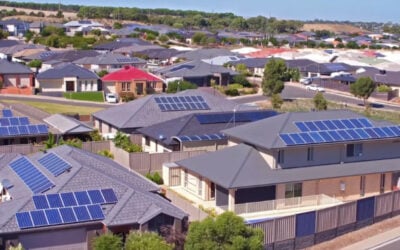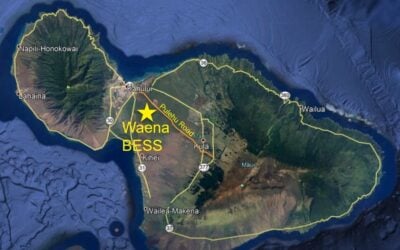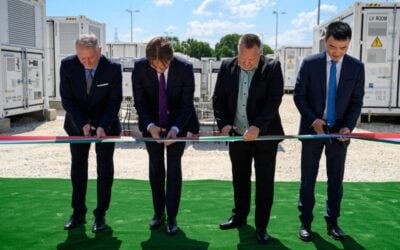2014 US Department of Energy infographic illustrates the “interdependent” relationship between energy and water. Image: US DoE.
Tesla batteries in microgrids will be deployed to help integrate renewable energy into California’s interdependent “water-energy nexus”, as the state faces it worst drought on record.
Inland Empire Utilities Agency, which serves around 830,000 people in California, said this week that it will install around 3.5MW of advanced energy storage systems in Southern California at water-recycling facilities and pumping stations. Designed at lowering energy costs and reducing demand on the grid, the storage will integrate renewable energy in the form of solar, wind and biogas, as well as grid resources.
Enjoy 12 months of exclusive analysis
- Regular insight and analysis of the industry’s biggest developments
- In-depth interviews with the industry’s leading figures
- Annual digital subscription to the PV Tech Power journal
- Discounts on Solar Media’s portfolio of events, in-person and virtual
According to a 2014 US Department of Energy (DoE) report, energy and water are inextricably linked and have an interdependent relationship (see infographic). In California alone, nearly 20% of all electricity generated is used to transport, heat and to treat water and waste water, while water and wastewater are responsible for 45 million tonnes of carbon dioxide emissions each year.
Integrating renewable sources into the water system will reduce onsite peak demand for energy from the grid by 14%, IEUA claimed, reducing total energy costs by as much as 10%. Renewable generators will be able to pool their power in a cost-effective way, while also adding backup capability in the event of power cuts to the grid.
The utility has in place a plan to be “gridless” by 2020, using “almost no capital outlay”. President of the board Terry Catlin said the latest step by IEUA to optimise renewable energy generation and use in its water system was testament to that strategic plan.
“Using energy storage to optimise those resources and dynamically control consumption is the next crucial step forward in IEUA’s strategic energy plan to go ‘Gridless’ by 2020 with almost no capital outlay by the Agency,” Catlin said.
Schwarzenegger’s former chief of staff heads California project
IEUA said that it will use Tesla’s Powerpack commercial energy storage product to power the water treatment plant, with systems to be designed and installed by Advanced Microgrid Solutions, which made recent headlines for not only being led by ex-California governor Arnold Schwarzenegger’s former chief of staff Susan Kennedy but also for convincing the ‘Governator’ to invest in the company himself.
Another well-known cleantech figure, Nancy Pfund of ‘social impact investor’ DBL Partners, recently explained why her company had picked out Advanced Microgrid Solutions as a target in two VC funding rounds this year. DBL selected investment opportunities based on the ability to deliver positive social impact, which meant AMS was a good fit, with their battery-based energy installations obviously far less carbon intensive than the fossil fuels they could replace and presenting an opportunity to deliver clean power in developing nations or regions that lack adequate grid networks.
Pfund also said that the leadership of CEO Kennedy was an indication of the calibre of professional now found in the energy storage and cleantech space – with the fact that Kennedy came through the policy and regulatory space another reason DBL saw AMS as an interesting prospect.
“[Susan Kennedy] has got all of these great technologies that she’s assembling and improving with software, but she also knows policy. She was Governor Schwarzenegger’s chief of staff, she was assistant chief of staff to Governor Gray Davis. She’s a former Public Utilities’ Commissioner for the state of California. I think she wrote the net metering bill regulation when she was there.”
“Compared to 10 years ago, the quality of the entrepreneurs in this business, their experience, their track record, their ability to grow companies, is just getting better every day,” Pfund said.
AMS will install systems of between 150kW and 1,250kW in size in the IEUA project. Susan Kennedy of AMS called the project “ground-breaking”.
“IEUA’s leadership when it comes to technology and water management is recognised across the whole industry. Tackling the water-energy nexus head on takes that leadership to a whole new level. This groundbreaking project is designed to optimise energy resources in the management, treatment and distribution of water while enhancing the reliability and resiliency of both the electric grid and water management systems,” Kennedy said.
Meanwhile IEUA board president Terry Catlin said the energy storage would help the utility make the most of previous and ongoing investments in clean energy assets.
“We are proud of our investments in energy efficiency, renewable generation and sustainable water management practices. Energy storage is the key to maximising the value of those investments, allowing us to use our resources more efficiently, reduce costs for our customers and participate in building a more resilient electric grid for the whole region,” Catlin said.






